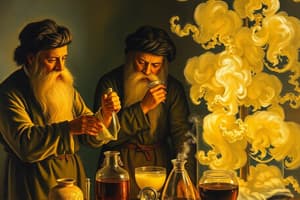Podcast
Questions and Answers
What is the primary purpose of the Haber process in agriculture?
What is the primary purpose of the Haber process in agriculture?
- To synthesize urea from ammonia.
- To reduce nitrogen volatility in the soil.
- To enhance soil structure.
- To produce ammonia from nitrogen and hydrogen. (correct)
How does temperature affect the yield of ammonia in the Haber process?
How does temperature affect the yield of ammonia in the Haber process?
- Lower temperatures generally favor the formation of ammonia.
- Higher temperatures always increase yield.
- High temperatures enhance reaction rates but can reduce yield. (correct)
- Temperature has no effect on reaction rate.
What role do urease inhibitors play in fertilizer application?
What role do urease inhibitors play in fertilizer application?
- They enhance nitrogen absorption by plants.
- They are unnecessary for most types of fertilizers.
- They help retain nitrogen in the soil. (correct)
- They increase nutrient loss through leaching.
What is the main goal of the Haber process in agriculture?
What is the main goal of the Haber process in agriculture?
Which nitrogen compounds can plants directly absorb for nutrition?
Which nitrogen compounds can plants directly absorb for nutrition?
What is a characteristic of reversible reactions in the context of nitrogen fixation?
What is a characteristic of reversible reactions in the context of nitrogen fixation?
Which of the following describes a disadvantage of not using additives in urea fertilizers?
Which of the following describes a disadvantage of not using additives in urea fertilizers?
In reversible reactions, which term describes the constant state achieved when forward and reverse reactions occur at the same rate?
In reversible reactions, which term describes the constant state achieved when forward and reverse reactions occur at the same rate?
How can the release of nitrogen from polymer-coated urea be delayed?
How can the release of nitrogen from polymer-coated urea be delayed?
Which process synthesizes ammonia from nitrogen and hydrogen?
Which process synthesizes ammonia from nitrogen and hydrogen?
What is the impact of using slow-release urea in fertilizers?
What is the impact of using slow-release urea in fertilizers?
What happens to the equilibrium of a reversible reaction if temperature is increased?
What happens to the equilibrium of a reversible reaction if temperature is increased?
At what point in the Haber process is pressure most critical?
At what point in the Haber process is pressure most critical?
What is the optimal temperature and pressure for the Haber process?
What is the optimal temperature and pressure for the Haber process?
What is the primary substance used in nitrogen fertilizers in agriculture?
What is the primary substance used in nitrogen fertilizers in agriculture?
Which method is used for applying fertilizers to optimize their effectiveness?
Which method is used for applying fertilizers to optimize their effectiveness?
What is the optimal temperature for the Haber Process?
What is the optimal temperature for the Haber Process?
What is the primary catalyst used in the Haber Process to maximize yield?
What is the primary catalyst used in the Haber Process to maximize yield?
How does increasing temperature affect the yield of ammonia in the Haber Process?
How does increasing temperature affect the yield of ammonia in the Haber Process?
What is urea primarily used for worldwide?
What is urea primarily used for worldwide?
What is the pressure required for urea production?
What is the pressure required for urea production?
What undesirable by-product is produced during urea manufacture?
What undesirable by-product is produced during urea manufacture?
Which of the following statements best describes the impact of pressure on ammonia production?
Which of the following statements best describes the impact of pressure on ammonia production?
Which of the following reactions occurs during the production of urea?
Which of the following reactions occurs during the production of urea?
Study Notes
Conditions for the Haber Process
- Temperature: 450°C
- Pressure: 250 atm
- Catalyst: Iron catalyst
The effect of temperature and pressure
- Lower temperature increases ammonia yield but slows reaction rate
- Higher pressure increases ammonia yield and reaction rate but is costly and risky
Urea
- Organic compound with the formula (NH2)2CO
- Contains carbon, nitrogen, oxygen, and hydrogen
Applications of Urea
- Primary nitrogen fertilizer used in agriculture
- Used in:
- dermatological products
- feedstock
- glue
- commercial products
- urea formaldehyde resins
- urea nitrate (explosive)
Urea Production Process
- Reacts ammonia and carbon dioxide at high pressure (35 atm) and temperature (135°C)
- Consists of two main reactions:
- Formation of ammonium carbamate: CO2 + 2NH3 → NH2COONH4
- Dehydration of ammonium carbamate to produce molten urea: NH2COONH4 → NH2CONH2 + H2O
- Undesirable side reaction:
- 2NH2CONH2 → NH2CONHCONH2 + NH3 (Biuret)
- Biuret is a by-product, but key component in promoting plant growth and increasing crop yields
Haber Process in Ammonia Production
- Invented by Fritz Haber in 1908
- Synthesizes ammonia from nitrogen and hydrogen gas under high temperature and pressure
- Primary source of ammonia for nitrogen fertilizers
Ammonia
- Crucial for providing nitrogen to plants, essential for plant proteins
- Plants cannot directly use nitrogen gas from the atmosphere and must absorb soluble nitrogen compounds from the soil
- Common nitrogen fertilizers include ammonium nitrate, ammonium sulfate, and urea
- A reversible reaction can proceed in both directions, eventually reaching equilibrium
Equilibrium
- Can be altered by changing conditions such as temperature and pressure
- To enhance nutrient retention in urea fertilizers, farmers can use slow-release urea or coat urea with water-insoluble polymers
- Polymer-coated urea can delay nitrogen release for up to several months after application
Studying That Suits You
Use AI to generate personalized quizzes and flashcards to suit your learning preferences.
Related Documents
Description
Explore the conditions and reactions involved in the Haber process and urea production. Understand how temperature and pressure impact ammonia yield and examine the various applications of urea in agriculture and industry. This quiz will test your knowledge of chemical processes and reactions.



